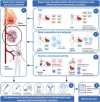A Phenomic Perspective on Factors Influencing Breast Cancer Treatment: Integrating Aging and Lifestyle in Blood and Tissue Biomarker Profiling
- PMID: 33597950
- PMCID: PMC7882710
- DOI: 10.3389/fimmu.2020.616188
A Phenomic Perspective on Factors Influencing Breast Cancer Treatment: Integrating Aging and Lifestyle in Blood and Tissue Biomarker Profiling
Abstract
Breast cancer is the most common malignancy among women worldwide. Over the last four decades, diagnostic and therapeutic procedures have improved substantially, giving patients with localized disease a better chance of cure, and those with more advanced cancer, longer periods of disease control and survival. However, understanding and managing heterogeneity in the clinical response exhibited by patients remains a challenge. For some treatments, biomarkers are available to inform therapeutic options, assess pathological response and predict clinical outcomes. Nevertheless, some measurements are not employed universally and lack sensitivity and specificity, which might be influenced by tissue-specific alterations associated with aging and lifestyle. The first part of this article summarizes available and emerging biomarkers for clinical use, such as measurements that can be made in tumor biopsies or blood samples, including so-called liquid biopsies. The second part of this article outlines underappreciated factors that could influence the interpretation of these clinical measurements and affect treatment outcomes. For example, it has been shown that both adiposity and physical activity can modify the characteristics of tumors and surrounding tissues. In addition, evidence shows that inflammaging and immunosenescence interact with treatment and clinical outcomes and could be considered prognostic and predictive factors independently. In summary, changes to blood and tissues that reflect aging and patient characteristics, including lifestyle, are not commonly considered clinically or in research, either for practical reasons or because the supporting evidence base is developing. Thus, an aim of this article is to encourage an integrative phenomic approach in oncology research and clinical management.
Keywords: biomarkers; breast cancer; clinical response; exercise; immunosenescence; lifestyle; physical activity; tumors.
Copyright © 2021 Arana Echarri, Beresford, Campbell, Jones, Butler, Gollob, Brum, Thompson and Turner.
Conflict of interest statement
The authors declare that the research was conducted in the absence of any commercial or financial relationships that could be construed as a potential conflict of interest.
Figures

Similar articles
-
Overview of resistance to systemic therapy in patients with breast cancer.Adv Exp Med Biol. 2007;608:1-22. doi: 10.1007/978-0-387-74039-3_1. Adv Exp Med Biol. 2007. PMID: 17993229 Review.
-
Breast Cancer Tissue Markers, Genomic Profiling, and Other Prognostic Factors: A Primer for Radiologists.Radiographics. 2018 Nov-Dec;38(7):1902-1920. doi: 10.1148/rg.2018180047. Epub 2018 Oct 12. Radiographics. 2018. PMID: 30312139 Review.
-
The DARC Side of Inflamm-Aging: Duffy Antigen Receptor for Chemokines (DARC/ACKR1) as a Potential Biomarker of Aging, Immunosenescence, and Breast Oncogenesis among High-Risk Subpopulations.Cells. 2022 Nov 29;11(23):3818. doi: 10.3390/cells11233818. Cells. 2022. PMID: 36497078 Free PMC article. Review.
-
Breast Heterogeneity: Obstacles to Developing Universal Biomarkers of Breast Cancer Initiation and Progression.J Am Coll Surg. 2020 Jul;231(1):85-96. doi: 10.1016/j.jamcollsurg.2020.03.035. Epub 2020 Apr 18. J Am Coll Surg. 2020. PMID: 32311464
-
Evaluating the physiological reserves of older patients with cancer: the value of potential biomarkers of aging?J Geriatr Oncol. 2014 Apr;5(2):204-18. doi: 10.1016/j.jgo.2013.09.001. Epub 2013 Sep 29. J Geriatr Oncol. 2014. PMID: 24495695 Review.
Cited by
-
The role of NLRP3 inflammasome in aging and age-related diseases.Immun Ageing. 2024 Feb 5;21(1):14. doi: 10.1186/s12979-023-00395-z. Immun Ageing. 2024. PMID: 38317229 Free PMC article. Review.
-
Comparison of Her2/Neu Oncoprotein in Serum and Tissue Samples in Women with Breast Cancer.Asian Pac J Cancer Prev. 2022 Feb 1;23(2):429-433. doi: 10.31557/APJCP.2022.23.2.429. Asian Pac J Cancer Prev. 2022. PMID: 35225453 Free PMC article.
-
Perioperative Risk Factors for Prolonged Blood Loss and Drainage Fluid Secretion after Breast Reconstruction.J Clin Med. 2022 Feb 3;11(3):808. doi: 10.3390/jcm11030808. J Clin Med. 2022. PMID: 35160259 Free PMC article.
-
The impact of climate, weather, seasonal transitions, and diurnal rhythms on gut microbiota and immune homeostasis.Antonie Van Leeuwenhoek. 2025 Jun 1;118(7):86. doi: 10.1007/s10482-025-02097-6. Antonie Van Leeuwenhoek. 2025. PMID: 40450648 Review.
-
Immune cell status, cardiorespiratory fitness and body composition among breast cancer survivors and healthy women: a cross sectional study.Front Physiol. 2023 Jun 1;14:1107070. doi: 10.3389/fphys.2023.1107070. eCollection 2023. Front Physiol. 2023. PMID: 37324393 Free PMC article.
References
-
- Global-Cancer-Observatory Estimated number of new cases in 2018, worldwide, both sexes, all ages (2018). Available at: https://gco.arc.fr/today/online-analysis-table?v=2018&mode=cancer&mode_p... (Accessed September 15, 2020).
-
- Kabel AM. Tumor markers of breast cancer: New prospectives. J Oncol Sci (2017) 3(1):5–11. 10.1016/j.jons.2017.01.001 - DOI
Publication types
MeSH terms
Substances
Grants and funding
LinkOut - more resources
Full Text Sources
Other Literature Sources
Medical

